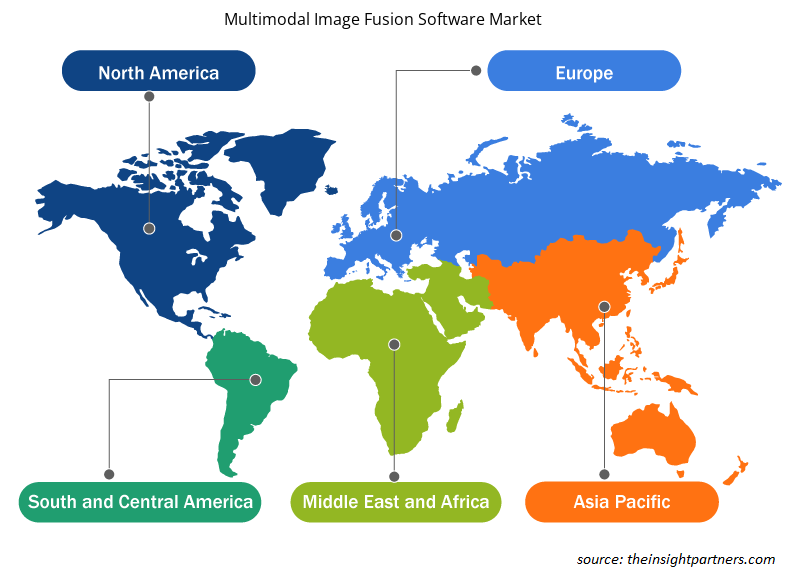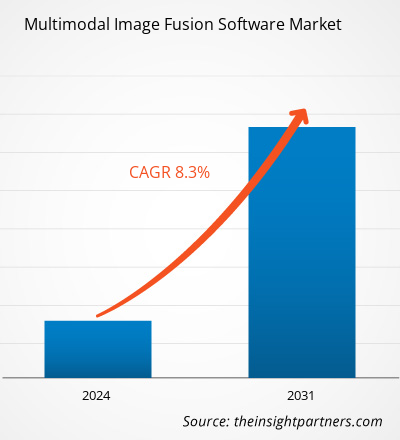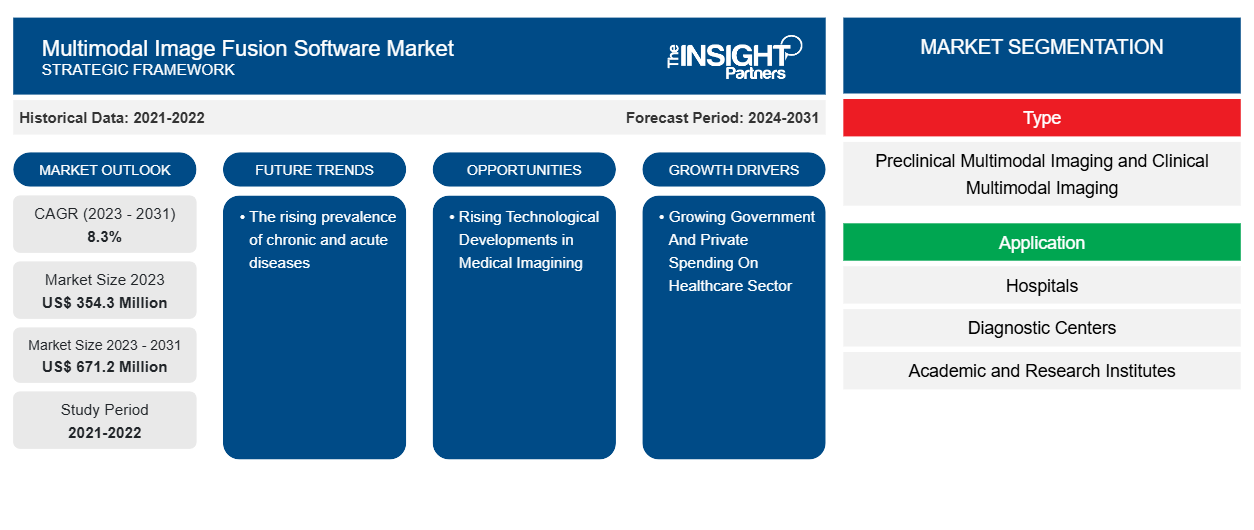Si prevede che la dimensione del mercato del software di fusione di immagini multimodali raggiungerà i 671,2 milioni di dollari entro il 2031, rispetto ai 354,3 milioni di dollari del 2023. Si prevede che il mercato registrerà un CAGR dell'8,3% nel periodo 2023-2031. È probabile che la crescente prevalenza di malattie croniche e acute rimanga una tendenza chiave nel mercato.
Analisi di mercato del software di fusione di immagini multimodali
Il software di fusione di immagini multimodali può produrre una visione più completa e accurata della scena fondendo numerose caratteristiche dei dati di imaging, il che aiuta nel processo decisionale e migliora le prestazioni del sistema end-to-end. Inoltre, i dati di imaging multimodali possono aiutare il processo decisionale e le prestazioni del sistema. La necessità di una tecnologia di fusione di immagini multimodali è in continua espansione grazie alla sua ampia gamma di applicazioni. Ad esempio, nell'imaging medico, la fusione di immagini multimodali può aiutare a migliorare la diagnosi e la pianificazione del trattamento unendo le informazioni da varie modalità di imaging.
Panoramica del mercato del software di fusione di immagini multimodali
Il software di fusione di immagini multimodali cerca di combinare informazioni importanti da immagini catturate da diversi sensori in un'unica immagine. Si prevede che le immagini fuse mantengano tutte le informazioni critiche dalle foto originali senza introdurre distorsioni o artefatti. Si prevede che il software di fusione di immagini multimodali svolga un ruolo importante in diverse applicazioni, tra cui guida autonoma, sistemi di sorveglianza e robotica. L'integrazione di dati da più fonti consente a questi sistemi di operare in contesti complessi e dinamici, aumentando efficienza, affidabilità e sicurezza.
Personalizza questo report in base alle tue esigenze
Riceverai la personalizzazione gratuita di qualsiasi report, comprese parti di questo report, o analisi a livello nazionale, pacchetto dati Excel, oltre a usufruire di grandi offerte e sconti per start-up e università
-
Scopri le principali tendenze di mercato in questo rapporto.Questo campione GRATUITO includerà analisi di dati che spaziano dalle tendenze di mercato alle stime e alle previsioni.
Driver e opportunità di mercato del software di fusione di immagini multimodali
La crescita della spesa pubblica e privata nel settore sanitario favorisce il mercato
La spesa pubblica e privata per il settore sanitario è in continua crescita in risposta a una migliore salute pubblica. Ad esempio, secondo i Centers for Medicare & Medicaid Services degli Stati Uniti, la spesa sanitaria nazionale (NHE) è cresciuta del 4,1% a 4,5 trilioni di dollari nel 2022, ovvero 13.493 dollari a persona. Rappresentava il 17,3% del Prodotto interno lordo (PIL). La spesa Medicare è cresciuta del 5,9% a 944,3 miliardi di dollari nel 2022, ovvero il 21 percento del totale NHE. 2021. Inoltre, le quote maggiori della spesa sanitaria totale negli Stati Uniti sono state sponsorizzate dal governo federale (33%) e dalle famiglie (28%). La quota delle imprese private di spesa sanitaria rappresentava il 18% della spesa sanitaria totale, i governi statali e locali rappresentavano il 15% e altre entrate private rappresentavano il 7%. La fusione di immagini multimodale svolge un ruolo fondamentale nel settore medico. È progettata esclusivamente per l'imaging medico. Questa strategia mira a rendere l'imaging medico più clinicamente rilevante per l'esame e la valutazione delle condizioni di salute riducendo il lavoro non necessario e migliorando la qualità. Consente una diagnosi più accurata e semplifica il processo diagnostico. Nella fusione di immagini mediche (MIF), un set fuzzy intuizionista (IFS) aiuta a migliorare la qualità dell'immagine, il che è utile per la diagnosi medica. Pertanto, la crescente spesa da parte del governo e della spesa privata nel settore sanitario sta guidando la crescita del mercato.
Crescenti sviluppi tecnologici nell'imaging medico
Le tecnologie di imaging medico sono in continua evoluzione, con conseguenti nuove applicazioni per la diagnosi e il trattamento delle malattie. Le nuove tecnologie di imaging medico promettono di migliorare direttamente i risultati per i pazienti. Le innovative tecnologie di imaging medico promettono di migliorare i risultati per i pazienti in vari modi. Ad esempio, i dispositivi di imaging mobili possono monitorare e diagnosticare pazienti anziani senza richiedere una sessione medica di persona . I gadget medici indossabili che includono componenti di imaging rendono più facile e più comodo per i pazienti segnalare fatti vitali, grazie ai quali i ricercatori medici stanno sfruttando l'intelligenza artificiale (IA), la realtà virtuale (VR), i computer indossabili e altri progressi tecnologici per migliorare l'assistenza sanitaria. I computer possono imitare circostanze del mondo reale in modi che consentono agli esseri umani di acquisire nuove idee e opinioni che vanno oltre la loro consapevolezza sensoriale. Inoltre, la fusione di immagini multimodale può aiutare a rilevare e trattare disturbi complessi unendo informazioni da più modalità di imaging come la tomografia computerizzata (TC) e la risonanza magnetica per immagini (RMI).
Analisi della segmentazione del rapporto di mercato del software di fusione di immagini multimodale
I segmenti chiave che hanno contribuito alla derivazione dell'analisi di mercato del software di fusione di immagini multimodali sono tipologia e applicazione.
- In base alla tipologia, il mercato del software di fusione di immagini multimodali è segmentato in imaging multimodale preclinico e imaging multimodale clinico.
- In termini di applicazione, il mercato è segmentato in ospedali, centri diagnostici e istituti accademici e di ricerca.
Analisi della quota di mercato del software di fusione di immagini multimodale per area geografica
L'ambito geografico del rapporto di mercato del software di fusione di immagini multimodale è principalmente suddiviso in cinque regioni: Nord America, Asia Pacifico, Europa, Medio Oriente e Africa e Sud e Centro America. Mentre gli ospedali e gli operatori sanitari in tutto il Nord America lavorano per digitalizzare le loro procedure, la domanda di aziende di sviluppo software sanitario qualificate cresce. Questo post include un elenco di importanti organizzazioni di sviluppo software sanitario pronte a realizzare un cambiamento trasformativo. La regione nordamericana domina l'adozione del software in ambito sanitario e in altri settori, grazie al suo alto tasso di adozione di soluzioni software mediche innovative e a una grande popolazione di pazienti, assicurando il suo predominio durante il periodo di proiezione. Tali casi creano opportunità redditizie per la crescita del mercato.
Approfondimenti regionali sul mercato del software di fusione di immagini multimodale
Le tendenze regionali e i fattori che influenzano il mercato del software Multimodal Image Fusion durante il periodo di previsione sono stati ampiamente spiegati dagli analisti di Insight Partners. Questa sezione discute anche i segmenti e la geografia del mercato del software Multimodal Image Fusion in Nord America, Europa, Asia Pacifico, Medio Oriente e Africa e America meridionale e centrale.

- Ottieni i dati specifici regionali per il mercato del software di fusione di immagini multimodali
Ambito del rapporto di mercato sul software di fusione di immagini multimodale
| Attributo del report | Dettagli |
|---|---|
| Dimensioni del mercato nel 2023 | 354,3 milioni di dollari USA |
| Dimensioni del mercato entro il 2031 | 671,2 milioni di dollari USA |
| CAGR globale (2023-2031) | 8,3% |
| Dati storici | 2021-2022 |
| Periodo di previsione | 2024-2031 |
| Segmenti coperti |
Per tipo
|
| Regioni e Paesi coperti |
America del Nord
|
| Leader di mercato e profili aziendali chiave |
|
Densità dei player del mercato del software di fusione di immagini multimodale: comprendere il suo impatto sulle dinamiche aziendali
Il mercato del software Multimodal Image Fusion sta crescendo rapidamente, spinto dalla crescente domanda degli utenti finali dovuta a fattori quali l'evoluzione delle preferenze dei consumatori, i progressi tecnologici e una maggiore consapevolezza dei vantaggi del prodotto. Con l'aumento della domanda, le aziende stanno ampliando le loro offerte, innovando per soddisfare le esigenze dei consumatori e capitalizzando sulle tendenze emergenti, il che alimenta ulteriormente la crescita del mercato.
La densità degli operatori di mercato si riferisce alla distribuzione di aziende o società che operano in un particolare mercato o settore. Indica quanti concorrenti (operatori di mercato) sono presenti in un dato spazio di mercato in relazione alle sue dimensioni o al valore di mercato totale.
Le principali aziende che operano nel mercato del software di fusione di immagini multimodali sono:
- Sistemi medici aycan, LLC
- Azienda Brainlab
- Società Bruker
- FUJIFILM VisualSonics, Inc.
- INFINITT North America Inc.
- Mediso Ltd
Disclaimer : le aziende elencate sopra non sono classificate secondo un ordine particolare.

- Ottieni la panoramica dei principali attori del mercato del software di fusione di immagini multimodale
Notizie di mercato e sviluppi recenti del software di fusione di immagini multimodali
Il mercato del software di fusione di immagini multimodale viene valutato raccogliendo dati qualitativi e quantitativi post-ricerca primaria e secondaria, che includono importanti pubblicazioni aziendali, dati di associazioni e database. Di seguito sono elencati alcuni degli sviluppi nel mercato del software di fusione di immagini multimodale:
- Intrasense SA ha rilasciato una nuova versione di Myrian 2.9, che è stata rilasciata. La nuova versione del software di imaging medico si è concentrata maggiormente sulle nuove funzionalità cliniche. (Fonte: Intrasense SA, aprile 2021)
- Bruker Corporation (Nasdaq: BRKR) ha annunciato il lancio di un nuovo sistema MALDI-TOF/TOF ad alte prestazioni, il neofleX Imaging Profiler per l'imaging dei tessuti basato sulla spettrometria di massa. Consente un facile output di file OME-TIFF tramite il nuovo software SCiLS Scope. Il sistema trasformativo neofleX MALDI-TOF/TOF MSI ora si adatta comodamente a un banco di lavoro. (Fonte: Bruker Corporation, giugno 2024)
Copertura e risultati del rapporto di mercato sul software di fusione di immagini multimodale
Il rapporto "Dimensioni e previsioni del mercato del software di fusione di immagini multimodale (2021-2031)" fornisce un'analisi dettagliata del mercato che copre le seguenti aree:
- Dimensioni e previsioni del mercato del software di fusione di immagini multimodali a livello globale, regionale e nazionale per tutti i segmenti di mercato chiave coperti dall'ambito
- Tendenze del mercato del software di fusione di immagini multimodali e dinamiche di mercato come driver, restrizioni e opportunità chiave
- Analisi dettagliata delle cinque forze PEST/Porter e SWOT
- Analisi di mercato del software di fusione di immagini multimodali che copre le principali tendenze di mercato, il quadro globale e regionale, i principali attori, le normative e i recenti sviluppi del mercato
- Analisi del panorama industriale e della concorrenza che copre la concentrazione del mercato, l'analisi della mappa di calore, i principali attori e gli sviluppi recenti per il mercato del software di fusione di immagini multimodale
- Profili aziendali dettagliati.
- Analisi storica (2 anni), anno base, previsione (7 anni) con CAGR
- Analisi PEST e SWOT
- Valore/volume delle dimensioni del mercato - Globale, Regionale, Nazionale
- Industria e panorama competitivo
- Set di dati Excel
Report recenti
Rapporti correlati
Testimonianze
Motivo dell'acquisto
- Processo decisionale informato
- Comprensione delle dinamiche di mercato
- Analisi competitiva
- Analisi dei clienti
- Previsioni di mercato
- Mitigazione del rischio
- Pianificazione strategica
- Giustificazione degli investimenti
- Identificazione dei mercati emergenti
- Miglioramento delle strategie di marketing
- Aumento dell'efficienza operativa
- Allineamento alle tendenze normative























 Ottieni un campione gratuito per - Mercato del software di fusione di immagini multimodali
Ottieni un campione gratuito per - Mercato del software di fusione di immagini multimodali